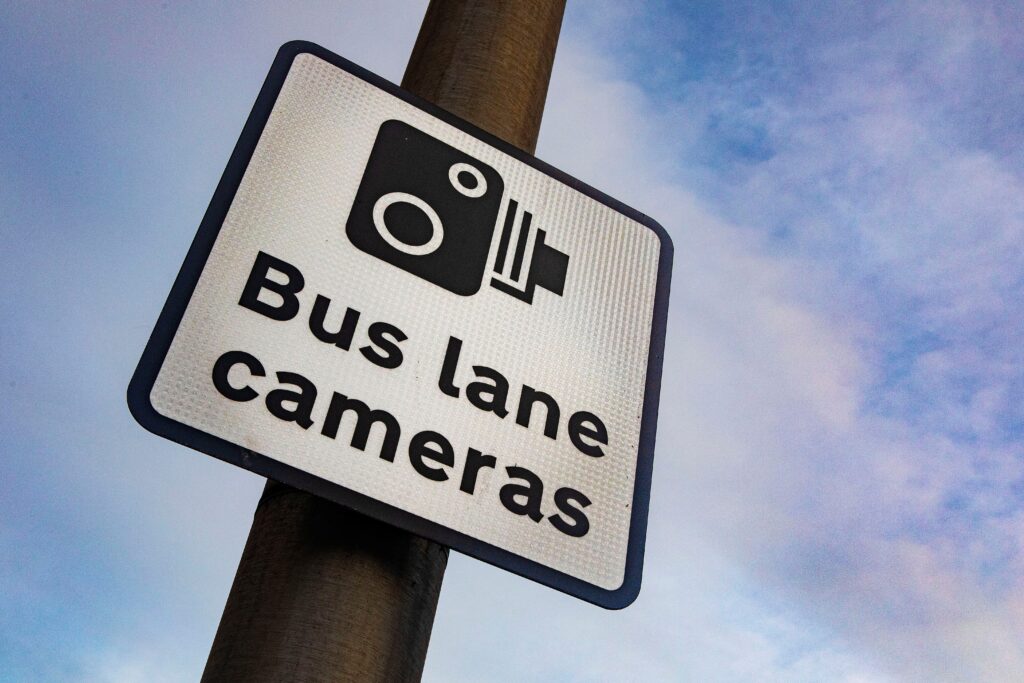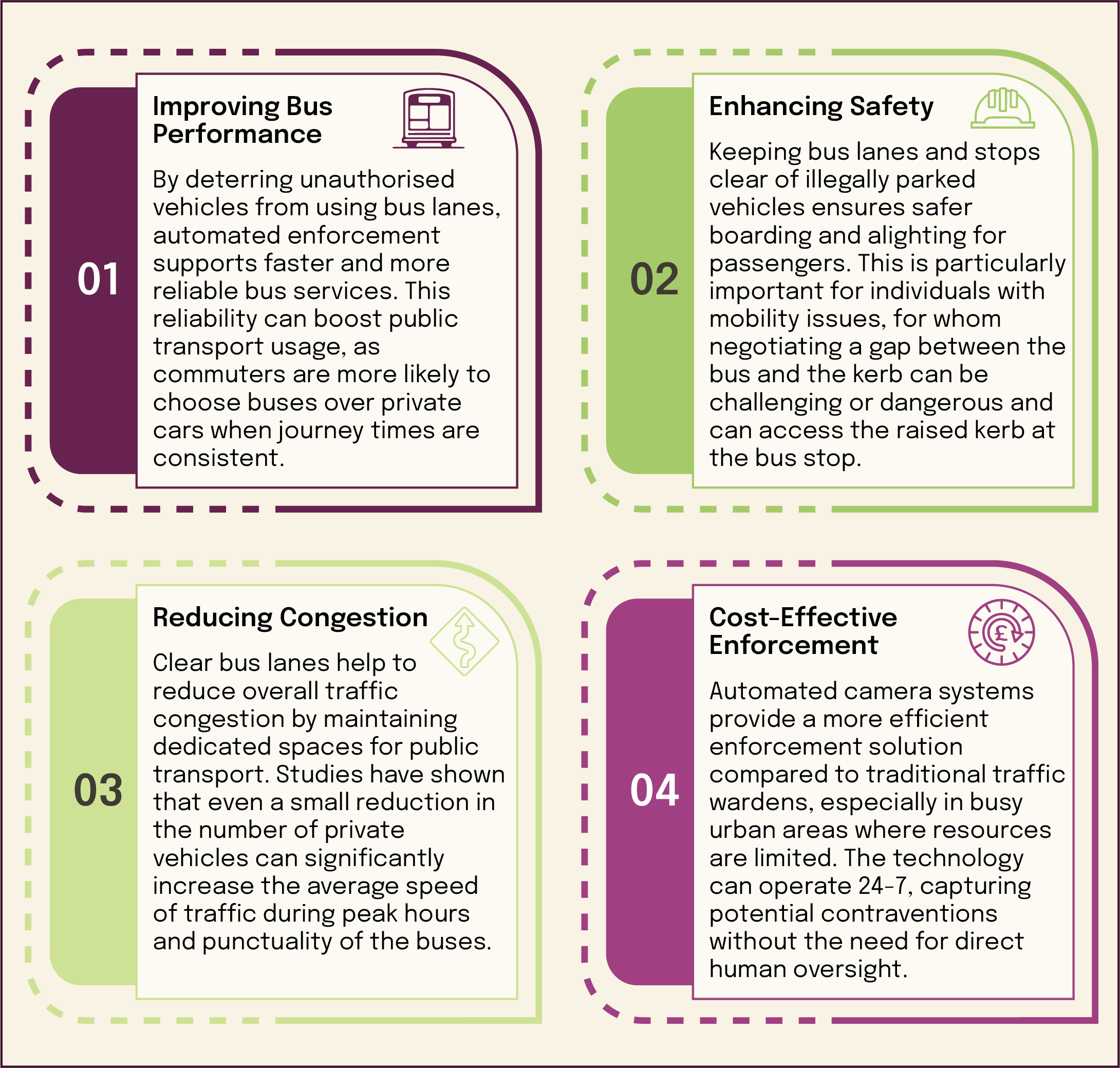Bus lane enforcement is increasingly important for improving public transport efficiency and safety across the UK. By leveraging camera technology, government agencies aim to enhance road safety, reduce congestion, and promote sustainable transport. The powers granted under the 2004 Traffic Management Act (TMA) part 6, fully enacted as of December 2021, enable government agencies to enforce moving traffic offences, such as banned turns and yellow box junctions, which pose road safety risks and cause congestion. Additionally, enforcing the illegal use of bus lanes [JV1] helps to reduce environmental impact and carbon footprint by supporting the use of public transport.
The Role of Camera Enforcement in the UK
For many years, UK government agencies have used cameras to monitor bus lanes, ensuring these spaces are reserved for buses, cyclists, and emergency vehicles. This enforcement helps maintain the flow of public transit, making bus services more reliable and encouraging the use of sustainable transport. The evolution from fixed cameras to redeployable systems, as well as mobile platforms, which utilise Automatic Number Plate Recognition (ANPR), allows for more adaptable and efficient monitoring of traffic violations and parking contraventions.
By discouraging illegal parking in bus lanes or at bus stops, camera enforcement helps maintain schedule reliability, crucial for public transport users. In the UK, delays due to illegal parking in bus lanes cost an estimated 1.5 million hours of delay annually, leading to significant disruption for both commuters and drivers. Studies indicate that clear bus lanes can increase average bus speeds by up to 10%, significantly reducing travel time. Keeping bus lanes unobstructed not only speeds up journey times but also enhances safety for all passengers, especially the elderly and disabled, who may find it challenging to board or disembark when a bus is unable to pull up to the kerb. In Ireland, the National Transport Authority highlights that illegal parking in designated bus zones is a primary factor contributing to delays, emphasising the need for effective enforcement to maintain reliable and accessible public transport services.

In fact, most contraventions enforceable by cameras address inconsiderate and dangerous parking or enhance road safety. A key example is School Keep Clear enforcement, which plays a vital role in protecting children and reducing accidents around school zones. In the UK, over 1,500 children are involved in road traffic accidents near schools each year, often linked to illegal or unsafe parking that obstructs visibility and increases risks for young pedestrians. By enforcing clear zones around schools, automated camera systems significantly improve child safety, reducing the likelihood of accidents and fatalities.
School Keep Clear zones, marked with yellow zig-zag lines, are designed to prevent vehicles from stopping too close to school entrances, where children frequently cross. When enforced by cameras, these restrictions have been shown to reduce dangerous parking behaviour by up to 50% within the first few months. In London, where camera enforcement is widely used, councils have reported noticeable reductions in contraventions, leading to safer school environments.
Automated Enforcement with Trellint Cameras
Under new regulations, government agencies can use automated, unattended cameras to address dangerous and inconsiderate driving and parking behaviour. These cameras extend beyond bus lanes, stops, school keep-clear zones, and red routes to cover additional critical areas such as yellow box junctions, which help keep main routes free of congestion. The regulations also target serious safety issues, including banned turns and wrong-way drivers on one-way streets.
These intelligent enforcement cameras, certified to Vehicle Certification Agency (VCA) standards, capture evidence of potential contraventions. During the first six months of an automated enforcement program, authorities are required to issue warning notices, allowing drivers to adjust to the new rules before penalties are enforced. To ensure fairness, government agencies must also establish an appeals process where qualified personnel review contested cases objectively, issuing fines only for verified violations. In compliance with data protection laws, footage without evidence of contraventions must be promptly deleted, following GDPR guidelines specific to each council.
Trellint cameras, which are VCA certified, play a key role in this process, meeting the high standards for enforcement technology in the UK. Their compliance ensures the cameras deliver accurate, reliable, and legally enforceable evidence and handle all evidence securely with encryption. This certification confirms adherence to strict data protection, encryption, and quality standards essential for a civil enforcement system, providing government agencies confidence in the reliability and effectiveness of their enforcement solutions.
Benefits for Government Agencies and
Public Safety
Automated enforcement of bus lanes brings multiple benefits, including:

Considerations for UK and Ireland Authorities Implementing Automated Camera Enforcement
As Government Agencies across the UK and Ireland embrace automated camera enforcement, several key factors must be considered to ensure successful implementation:
1. Compliance with Legal and Regulatory Standards: Authorities must ensure that the camera technology complies with local legal standards. In the UK, equipment must be certified by the VCA to ensure accuracy and reliability. In Ireland, compliance with national traffic and data protection regulations is essential. Authorities should also ensure data collection adheres to GDPR requirements, including secure handling and limited retention of footage.
2. Public Awareness and Communication: Effective enforcement requires public understanding of the rules and the technology’s purpose. Government agencies should:
- Educate the public on the measures being implemented, including the location and types of violations monitored.
- Explain the benefits, such as improved bus reliability and reduced congestion.
- Implement an initial grace period with warning notices to help the public adjust to the new system.
3. Fair and Transparent Enforcement Processes: To maintain public trust, authorities must implement transparent enforcement processes, including a clear appeals procedure and the impartial review of video evidence. Providing comprehensive information about each offence in Penalty Charge Notices (PCNs) is also essential.
4. Selecting the Right Technology: The choice of camera type and placement is crucial. Options include fixed cameras for busy areas and mobile ANPR systems for broader coverage. VCA-compliant equipment, such as Trellint cameras, ensure evidence is captured and managed in a secure manor as well as producing high standards of accuracy and compelling high-definition evidence as is the case with Trellint cameras.
5. Impact on Traffic and Urban Mobility: Automated enforcement can encourage the use of public transport by keeping bus lanes clear, supporting active travel initiatives, and aligning with urban mobility policies, such as low-emission zones as well as addressing dangerous and inconsiderate road users’ behaviour such as child safety outside of schools or illegal turns which are a major safety issue
6. Review and Evaluation: Regularly reviewing enforcement outcomes allows authorities to adapt strategies, relocate cameras, or expand the technology’s use based on data-driven insights.
Supporting Vision Zero Goals
The UK’s Vision Zero initiative aims to eliminate all traffic-related deaths and serious injuries while promoting safe and equitable mobility for everyone. Automated enforcement technology plays a crucial role in achieving these goals by:
- – Reducing the number of traffic violations, contraventions and accidents.
- – Providing data-driven insights to inform future road safety improvements.
- – Minimising the need for on-road enforcement, allowing police to focus on other public safety duties.
Data Sharing and Technological Standards
To maximise the benefits of automated enforcement, government agencies need to standardise and share data effectively. Initiatives like the National Parking Platform (NPP) and the Alliance for Parking Data Standards (APDS) support this by creating frameworks for data interoperability. These efforts help government agencies share insights and best practices, ensuring the consistent application of enforcement standards across different regions.

Moving Forward with Automated Bus Lane Enforcement
The full implementation of the Traffic Management Act empowers UK government agencies to adopt automated bus lane enforcement and a wide range of moving contravention types, enhancing public transport and supporting sustainable urban development as well as making our roads safer. With VCA-compliant Trellint cameras, government agencies can be assured of using high-quality, reliable enforcement tools that meet regulatory requirements.
As government agencies take on these new powers, automated enforcement is not just about issuing fines; it’s about compliance, making cities more liveable and ensuring that public transport remains an attractive option for everyone. The combination of VCA-compliant technology, data-driven insights, and sustainable transport policies sets the stage for a cleaner, safer, and more connected urban environment.
What to Do Next?
Irrespective of where you are in your camera journey, speak with one of our experts who could support you in moving your municipality forward. We are here to help and already offer services such as:
- Support in gaining approval from the Department for Transport to implement camera enforcement, drawing upon over a decade of experience in helping government agencies to adopt cameras for civil enforcement Site surveys to understand where the challenges are and how best to change behaviours, as well as the suitability of enforcing the location.
- Full end-to-end camera solutions for schemes covering zero emissions zones, parking, bus lane and moving contravention enforcement.
- Trellint will manage all aspects of the VCA certification for the council.